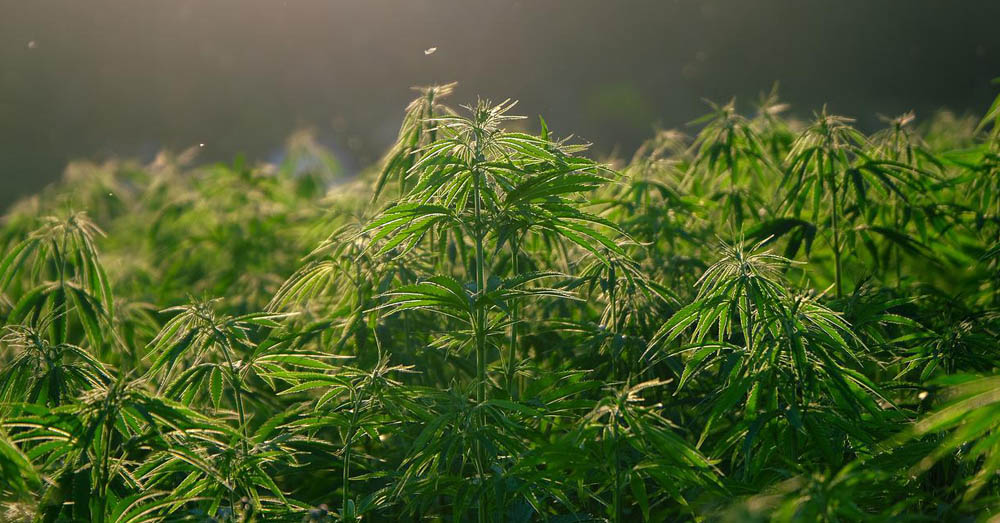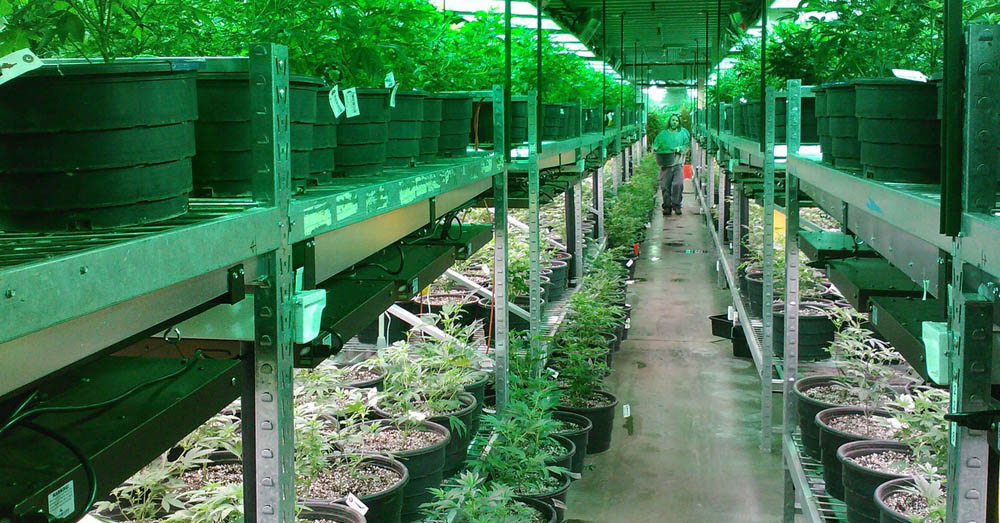Not everyone has the space to create a garden outdoors — and gardening indoors is definitely not the easiest thing to do.
For budding home growers, grow tents is a great solution. They are not only convenient, but they also allow you to regulate growing conditions.
Before purchasing a tent, you also need to consider some important factors.
So, in this article, you’ll find out everything you need to know about grow tents.
What Is a Grow Tent?
A grow tent or a grow room is a tall, compact fabric box lined with reflective interior walls to grow plants indoors year-round.
The outer lining is typically made from heavy-duty fabric like nylon or polyester. It’s held up by metal poles slotted together to make a strong frame.
The inner lining is often made from Mylar, which is designed to be extremely reflective to maximize light exposure of the plants inside.
Grow rooms are available in various sizes, features, and prices.
They allow you to control different aspects of the plant environment inside the compact tent. It’s equipped with several openings and other equipment, such as:
- Circulation and exhaust fans
- Grow lights, metal halide, and sodium vapor lamps
- Heaters
- Humidifiers
- Air conditioners
Using a grow tent allows you to control temperature and humidity levels to get the desired results.
What Are Grow Tents Used For?
Because the space of a tent is limited, it’s mainly used for cultivating high-dollar crops for personal use.
Due to their limited capacity, these tents are NOT suited for industrial or commercial purposes.
Grow tents are normally used to cultivate marijuana — however, they’re also used to grow vegetation, such as:
- Mushrooms
- Peppers
- Green beans
- Carrots
- Leafy greens
With indoor grow tents, you can make plants grow faster, taller, or bear bigger fruits within a controlled environment.
You are essentially creating an artificial climate that would be impossible to replicate in an outside environment.
A grow tent helps grow different plants that may not grow natively in your specific locality.
You can control and maintain a grow tent’s ventilation and light conditions to the desired levels to support the different stages of the growth cycle.
How Do Grow Tents Work?
A grow tent is a controlled environment containing various equipment that can regulate lights, temperature, and humidity.
A good grow tent has electrical access to lights and a ventilation system for temperature control.
See the following components of a grow room and how it works to efficiently produce plants:
Light Conditions
Plants NEED light to power their growth.
Grow tents use high-powered grow lights to mimic natural sunlight. To help, the silver inner lining ensures maximum light reflectivity to the plants.
ALL parts of the plant are exposed to light, compared to natural environments where the lower parts are often in the shadows.
The light-proof or “light tight” feature of grow tents also keeps light from coming in or out. This ensures minimal light leakage.
It’s effective for growers who want to simulate the 24-hour light cycle necessary for plants to grow.
Your plants receive light (and darkness) when you want them to.
Temperature
Due to the enclosed structure of a grow tent, it provides great insulative properties to retain heat.
Unlike the unpredictability of external temperature changes, you can directly regulate the temperature according to your plants’ needs.
Alongside the glow lamps, the ventilation system manages the temperature and air circulation within the grow tent.
A grow tent has several ports that give access to the necessary equipment to control cooling, humidity, ventilation, and more.
Regardless of the external temperature, a grow tent creates a stable environment that can let your greens grow as efficiently as possible.
Humidity
The combination of light and temperature conditions determines the humidity levels in a grow tent.
Humidity is an important aspect that directly impacts a plant’s transpiration rate.
Transpiration refers to the evaporation of water from a plant’s surface. It also assists in driving water and nutrients to various parts of the plant.
It’s a MAJOR component in guaranteeing plant health.
High humidity levels in a grow tent can result in molding and rotting, which can ruin your yield.
TIP: It’s important to clean the tent regularly to ensure healthy cultivation. This also prevents bacteria and fungi from growing.
Using a thermometer and hygrometer, you can closely monitor the lighting and temperature for a balanced humidity.
The contained environment of a grow tent means that your plants’ growth remains unaffected by outdoor weather changes and other factors.
What Are the Benefits of Using Grow Tents?
Whether you’re tending to mother plants or growing clones, grow tents have much to offer when it comes to indoor gardening.
Let’s look at the benefits of grow tents over other growing options:
1) Improves Photosynthesis
Grow rooms have “light-proof” Mylar interior lining that reflects light at every angle and prevents light leakage.
In an outdoor garden, insufficient sunlight often causes yellowing leaves in shadowed parts of the plant.
With a grow tent, you control the intensity and exposure of lights that your indoor cultivation receives.
Because of the reflective interior walls, ALL your plants receive plenty of lighting from the grow light.
2) Gives You Environmental Control
A grow tent gives you COMPLETE control of your plants’ growing environment.
Using lights, humidifiers, and different equipment, you can regulate and maintain the light, water, humidity, and temperature your plants receive.
You don’t have to worry about rain or excessive heat that can affect the growth of your plants.
Grow tents have flood-proof floors and sealed ports to help keep out pests and protect against potential flooding.
It’s an artificial garden where you can create the ideal growing conditions for any plant you want to grow.
3) Energy Efficient
Grow tents are built to maximize energy efficiency.
The Mylar interior walls reflect and amplify light without requiring excessive energy from the grow lamp.
Light is diffused throughout the grow tent instead of a centralized source.
As a result, it helps speed up photosynthesis for your plants.
4) Saves Money
The energy efficiency of a grow tent means you can also cut back on costs.
Due to its smaller size, a grow tent is less expensive than setting up a large growing environment in a whole room.
A grow tent also reduces the risk of losing crops due to pests, flooding, and weather changes.
The controlled environment means no excess expenses for pesticides and garden maintenance, so you save money in the long run.
5) Controls Odor
Not only do grow tents prevent things from coming in, but it also keeps things from going out.
The airtight seals of a grow tent confine unwanted odor from seeping outside.
Certain plants produce allergens and scents that can affect indoor air quality. A grow tent prevents odors from diffusing into your home.
Grow tents are also beneficial for growers who plan to use chemicals or fertilizers for their indoor garden.
Factors to Consider When Choosing the Right Grow Tent
From the temperature to the humidity, grow tents help create the best growing conditions for any plant.
Finding the perfect grow tent will depend on several factors, such as the number of plants you want to grow and the available space you have.
Here are tent-buying tips you should consider before purchasing a grow tent:
1) Space
For people living in cities or urban areas, finding adequate space for a grow tent may be challenging.
Fortunately, you don’t need an entire room to create an indoor garden.
You need to consider how much space you have at home and find the right grow tent kit.
“Shorty” tabletop tents are small enough to fit in the corner of a room. These are ideal for growers who want to clone seeds or start with small plants.
Free-standing grow tents also require more overhead and ground space, such as in an empty closet or garage.
Additionally, you must consider how many plants you want to fit inside to get the right size tent.
2) Material
High-quality grow tents are made from heavy-duty fabric, such as nylon or polyester, bonded to a reflective inner lining.
The thickness of the fabric is measured based on density (D).
The higher the number, the stronger the fabric is. Grow tents typically have ratings ranging from 200D to 1680D.
The perfect grow tent should have a durable fabric to maintain optimal growing conditions.
Among the best-selling tents on the market is the Gorilla Grow Tent with 1680D reflective walls.
The interior walls of a grow tent are made from Mylar or polyethylene terephthalate, which has 50% to 90% reflective capacity.
Get a grow tent with maximum reflectivity for better light coverage and less energy expenditure.
3) Features
Grow tent kits require different equipment to operate, which can differ depending on the product.
To ensure the best indoor growing conditions, grow tents should have a grow light, ventilation fans, dehumidifiers, and other components.
A good grow tent should have a rigid frame and access ports to support the accessories you want to add.
Frames will be exposed to extreme temperatures constantly, so they should be strong enough to withstand the pressure.
Some of the sturdiest grow tents have frames made of steel.
Ports are primarily used to connect equipment (such as ventilation and electricity) to the grow tent. Certain grow tents can have multiple openings, while others may only have a double flap.
The kind of access ports you need depends on the equipment you intend to use.
4) Plant Species
The type of grow tent you should purchase should be able to accommodate the plants you want to cultivate.
If you want to grow small plants, a short grow tent where you can reach inside should be enough.
For tall plant species, you would want a grow tent that can fit the plants AND the necessary equipment inside.
You also have to account for how tall and how many plants you want to place inside the grow tent.
Depending on the plant species, you can expect some monster plants to take up space.
5) Budget
Not only are grow tents energy efficient, but they’re also relatively affordable. You can find many all-purpose grow tents for under $400.
A budget-friendly grow tent can go as low as $90. Meanwhile, mid-range grow tents with variable heights cost upwards of $200 on average.
At the other end of the spectrum, high-quality, heavy-duty grow tents can cost anywhere between $400 to $1,000.
Expensive grow tents offer innovative features and ample growing space, but there are great value buys for half the price.That said, a well-built grow tent with solid performance means sparing expense for top-quality products.
Top Growing Tents
Now that we’ve discussed the components and advantages of a grow tent, you might be wondering what tent to get.
Below are some of the best grow tents trusted by professional and seasoned growers alike for indoor growing:
1) Gorilla Grow Tents
Among the most highly recommended brands on the market is Gorilla Grow Tent.
A Gorilla Grow Tent from the GGT Line is built to be durable and packed with features.
Gorilla Grow Tents run taller than average at more than 6′ tall. If that’s not enough, add height extenders to give plants more “wiggle room” as they grow.
What makes Gorilla grow tents stand out is their 1680D diamond fabric.
This feature ensures less noise pollution, more light-proofing, and improved durability.
The most popular in the standard GGT line is the 2x4x6 Gorilla Grow tent, with a 1680D, five ducting ports, and 2 electrical access.
Gorilla Grow Tent’s 4x4x6 Lite Line Tent and the 4x8x4 Shorty Tent are also great options for lightweight, space-saving tents.
2) Mars Hydro
Known for high-quality grow tents at an affordable price, Mars Hydro is a popular choice for home growers and hobbyists.
Mars Hydro grow tents are equipped with powerful grow lights and thick frames that are second to none.
Most tents have a viewing window, diamond-patterned Mylar lining, and dual cinching ducting ports for optimal indoor growing.
Mars Hydro’s 8×8 Grow Tent can hold up to 14 to 16 plants.
With an extra thick double-layer fabric and durable zippers, you can be sure it’s COMPLETELY lightproof.
AMIATCH Mars Hydro 300W Full Spectrum is another grow tent from Mars Hydro worth considering.
3) VIVOSUN
If you’re in the market for a reliable tent at a great value, Vivosun has a great lineup of products for indoor growing.
Vivosun grow tents are constructed from 600D thread canvas weave, creating an effective seal to protect your garden.
Not as thick as denser grow tents, the lower density allows these tents to come at an affordable price point.
A Vivosun tent has all the bells and whistles a novice grower would need.
The Vivosun 2×3 model is a multi-chamber tent that lets you separate different species from other plants.
With easy-access zippers and door fasteners, you can easily monitor your greenery. It packs all the same features as a high-end tent at half the price.
4) Secret Jardin
Secret Jardin offers multiple grow tents at various price points and quality levels. Although not as well-known as other brands, it’s gaining momentum on the market.
Perhaps the most noteworthy product line is their Dark Propagator line, which is intended for the propagation phase.
Secret Jardin Dark Street 120 is the most popular line for many beginners.With highly reflective inner walls, steel poles, and a 4×4 form factor, you can grow as many as 6 to 8 plants inside.
Frequently Asked Questions
Grow tents are certainly convenient to have. Below are more related questions that people frequently ask about grow tents:
How Many Plants Can Fit Inside a Grow Tent?
The number of plants a tent can hold depends on the kind of plant you’re growing and the size of the pots.
Plants should be given enough space to grow, so it’s not recommended to use small pots to fit more in a single tent.
You can fit more pots with small greens than large or fruit-bearing plants.
Plant species that grow laterally should be placed at least 2 inches apart.
Should I Get a Multi-Chamber Grow Tent or Multiple Grow Tents?
Many growers like to have separate spaces for vegetative and flowering phases.
Some tents are even designed with multiple chambers within a single tent for this purpose. They help keep your indoor cultivation organized but may have limited interior space.
Multiple tents are preferred for growing larger greens and producing bigger yields.
Conclusion
A grow tent gives you maximum control over the growing environment.
It has various equipment like grow lamps, humidifiers, and ventilation fans that ensure maximum yield.
Before buying a grow tent, it’s important to consider your budget, available space, and the plant species you plan to grow.
Keep all of these in mind, and you’re on your way to buying the right growing tent!




